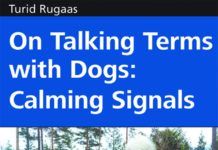Learning to Translate Their (Body) Language
Because you're in a rush, you call your dog in a somewhat irritated voice to come back to you once he's had his walk off leash. But just to get your goat, it seems, he makes his way toward you slowly — and in a curve rather than a straight line, which only makes him take longer. And the more annoyed you get, the more slowly he goes. So of course you scold him once he gets to you.
Or perhaps you want your dog to do something, and his response is to act "stubborn," or perhaps "distracted." Maybe you're yelling at him to comply one way or another and all he does is sniff the ground.
Identifying Canine Stress
Our canine friends become stressed for the same reasons we do, says On Talking Terms with Dogs: Calming Signals. First and foremost, that means situations where they do not feel they can cope but also instances in which they feel the threat of pain or discomfort.
They show it by exhibiting calming signals — signals that, to another dog, are invitations to relax because no harm is meant. If you see these calming signals in your dog, try to figure out what you can do to limit his stress.
Coping With the Loss of your Dog
Do Unto Animals
Bet You Didnt Know…
1. At the beginning of the twentieth century, pit bulls were among the most popular family dogs, even given the moniker nanny dogs. In the 1980s, they became the dog of choice for drug dealers, dogfighters, and gangs, living in deplorable conditions and becoming aggressive as a result of their circumstances. Much of their …
When a Pet Dies
When I was little and didnt have a sister yet, my best friend was a brown, wire-haired mongrel named Mitzi. We shared joyous times, exciting times and sad times. We got scared together when there was thunder and lightening, and together we crawled under the bed until they went away. When I wasnt scared of them any more, Mitzi still was, so I comforted her and felt all the braver.








